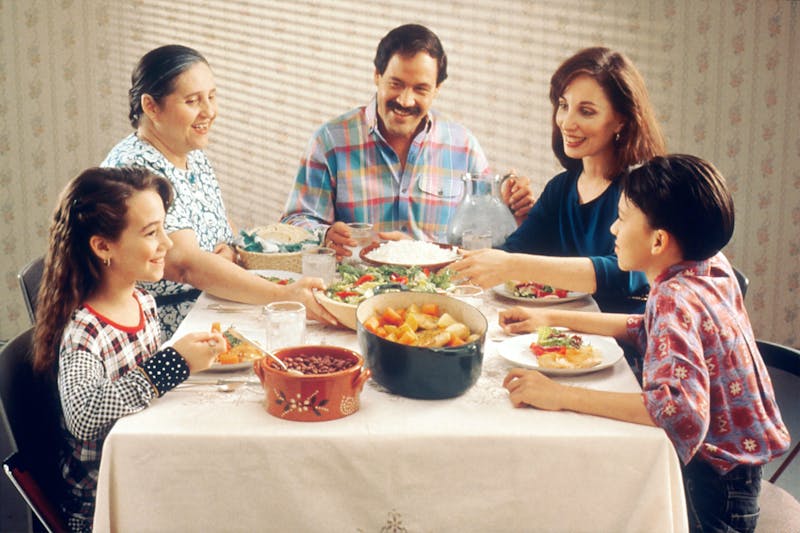
Follow these expert-recommended strategies to help your child lose weight. And know when it’s time to talk with a professional
In recent decades, childhood obesity has become one of the most serious youth health epidemics in America.
18.5% of children and adolescents in the US are obese. But this wasn’t always an issue. It’s one that’s been rising in recent decades because of certain lifestyle factors.
Children today are more likely to eat out regularly, exercise less, have more access to high fat and high sugar processed foods, and spend more time doing sedentary hobbies—watching TV and playing video games.
All of these have contributed to a growing problem for children and teens that goes beyond being overweight. Childhood obesity comes along with other health concerns like depression, diabetes, sleep apnea, heart disease, asthma, and high blood pressure.
So it’s important to tackle this issue early to prevent other serious health problems from arising.
But losing weight isn’t easy. It’s complex and there isn’t a one size fits all solution.
So here are some of the top suggestions to help your child lose weight so their health can improve, and they can live happier and longer lives.
1. More movement
Getting more movement each day is one of the most important things a child can do to start losing weight.
You can help by signing them up for a sport or activity that requires them to move for at least an hour each day. It may take a few tries to find an activity they really enjoy. But it’s worth the time investment to discover an activity that will keep them moving.
It’s also a good idea to restrict screen time and encourage time outdoors. This is especially important on the weekends when there’s more time in their day for activity.
There’s little you can do about the hours they spend sitting in school (or in front of the screen for online school now). But on the weekends is the time to ensure they’re not spending all day in front of a screen.
Many electronic devices and apps can have restrictions and timers set up to limit how long they can be used or who can login and use them. This is an easy way to enforce a limit on their screen time.
2. Restrict Access to Processed Foods
Processed foods are everywhere. And we can’t deny that many of them are delicious. But to make these foods a big part of the diet is one of the leading causes of youth weight gain.
What do we mean by processed foods? Foods that you find on the grocery store shelves that are premade and full of extra salt, sugar, oils, and preservatives to make their shelf-life longer. Foods like frozen pizza (or any frozen meal), cookies, canned foods, and chips, are some of the most highly processed foods. And they have a higher calorie count than making those foods yourself from scratch.
It’s essential to restrict access to these and replace them with whole foods to help your child lose weight.
This doesn’t mean you have to do anything crazy.
One of the easiest ways to change their diet is to replace their high calorie, low satiety snacks with low calorie, high satiety snacks. The same thing we suggest for adults looking to lose weight.
Instead of buying Cheeots, have popcorn in the house. Instead of frozen french fries, make homemade baked, mashed, or lightly fried potatoes with far less oil than used in the premade options.
Stock the house with fruits, vegetables, nuts, and low-sugar yogurts.
When they are hungry but there’s nothing else around to eat but these healthier options, they’ll have no choice but to eat them. And over time their palette will adjust to these foods. And they’ll crave the highly-processed foods less and less over time.
This also doesn’t mean that you have to go all or nothing when it comes to treats. When an occasion comes up and your family wants pie, or cake, or cookies. Great. That’s the time to indulge.
But it’s not necessary to have all of those foods in the house at all times.
3. Eat out less
This one’s tough for working families and anyone who is short on time. (Aren’t we all?)
Cooking is time-consuming. But it is one of the most important things to do for the family when it comes to nutritional health and managing obesity.
When you cook from home you know everything going into those dishes.
A lot of those meals you get when you eat out taste so delicious because they sneak in all kinds of extra oils, fats, and sugars. This means the same dish at a restaurant is going to have more calories than it does when you make it at home.
There are a lot of ways to make cooking easier and take up less of your time.
It’s possible to cook only a couple nights in a week instead of every night if you buy enough ingredients to always have leftovers. This gives you and the family extra servings for meals later in the week. And saves you from having to cook another night or two.
You can also meal prep on one day of the week and make enough for the family to have a variety of dinners throughout the rest of the week.
And if possible, pack a lunch for the kids to eat at school every day. This is something that older kids can do for themselves when given the right variety of options to choose from. Plus they gain that sense of self-sufficiency by taking care of their own meals.
4. Encourage kids to try new things
This counts for both activity and food.
It can be tough for a teen to want to try new things. There are all kinds of social and other concerns that they’re consumed by that we oftentimes forget.
But it’s important to encourage them to try new activities that can get them out in the world and spending less time in front of the TV and on their phones. This helps them increase their activity and expend more calories throughout the day.
And it’s important to encourage your kids to try new foods. It’s easy for kids, and for anyone really, to get into a habit of eating the same few foods they’re comfortable with. It’s crucial in this time of development to encourage them to try as wide a variety of foods as possible. Show them the range of delicious fresh foods and healthy meals that exist from all over the world.
This adventurous way of eating makes it more likely they’ll find whole foods they enjoy and want to make a regular part of their diet.
5. Make it a family plan
The truth is, while it may not seem like it sometimes, all kids and adolescents look to the adults in their life for guidance and as a model for how to live.
So when you model healthy habits, they’re more likely to pick those up.
One of the best ways to make healthy habits that benefit your kids (and you) is to make any lifestyle changes in diet and exercise a family change—not just one for the child.
This prevents the lifestyle changes in activity and nutrition from feeling like a punishment for your child.
So make it a positive and exciting change not just for your child, but for the whole family. There are so many ways to make these changes that the whole family can enjoy. Make family bike rides a regular activity. Go swimming, go for walks, go hiking together—it could be anything.
Buy healthy food options. Cook with your kids. Teach them how they can be aware of, and control, what they eat. And talk to them about the outcome of healthful eating versus convenience eating of highly processed foods.
When to get expert advice?
If you’re worried about your child’s weight, it’s always smart to get insight from an expert.
While these tips are a helpful starting point, if you’re feeling overwhelmed and like it’s not enough, then it’s time to talk to a physician about how to help your child lose weight.
At Valley Medical Weight Loss we have doctors who help you find the best solution for your child. We know that making weight loss happen isn’t always easy for complex reasons that are often environmental, psychological, and physical in nature. So we help you and your child work through those barriers to weight loss with compassion and understanding.
We offer weight loss plans that ensure your child can lose weight safely and still get the total nutrition they need. We provide a meal plan, probiotics, multivitamins, weekly weigh-ins, and physician consults. And if it’s the right option, you can also get an FDA approved appetite suppressant for youths over 12 years old.
The reality is that getting a handle on childhood obesity early has so many health impacts on their life as healthy adults.
Read more about our youth weight loss program and contact us to set up your appointment today.
Sources:
- “Childhood Obesity Facts.” Centers for Disease Control and Prevention, Centers for Disease Control and Prevention, 24 June 2019, www.cdc.gov/obesity/data/childhood.html.
- “Childhood Obesity Causes & Consequences.” Centers for Disease Control and Prevention, Centers for Disease Control and Prevention, 2 Sept. 2020, www.cdc.gov/obesity/childhood/causes.html.

